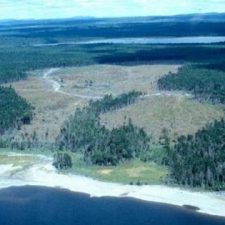
Forest carbon pool development over 35 years in a balsam fir-red spruce forest in northern central Maine after stem-only and whole-tree harvesting
- Barusco, Bruna
University of Copenhagen - Grigaite, Agne
University of Copenhagen
Research at Weymouth Point Study Area in Maine, USA, was designed to evaluate short- and long- term impacts on nutrient pools in a spruce-fir forest ecosystem following whole-tree harvesting (WTH), stem-only harvesting (SOH) with return of lopped (LOP) or chipped (CHP) residues to the site, compared to an unharvested Reference forest (REF). The 73 ha REF and 48 ha clear-cut watersheds were sampled in 2016 to estimate forest carbon (C) pools 35 years after clear-cutting in 1981. Statistical analysis by use of a General Linear Model (GLM) procedure of SAS for above and belowground biomass, deadwood, forest floor (FF) and mineral soil C pools found no statistically significant differences between WTH and SOH (p>0.05). FF of SOH and REF were not significantly different, but WTH had less FF than REF (p≤0.05). Living aboveground biomass at age 35 years had accumulated 60% of C contained in pre-harvest forest (70 Mg C -1; in 2016 versus 116 Mg C ha-1; in 1979); however, the FF lost 6-22 Mg C ha-1. In 2016, REF forest contained 16 Mg C ha-1; deadwood (part of dead organic matter (DOM)) compared with 6, 5 and 7 Mg C ha-1; in WTH, LOP and CHP treatments, respectively. Total soil C content to 100 cm depth (DOM) was not significantly affected by clear-cutting: 120 Mg C ha-1; for REF versus 115 Mg C ha-1; for WTH, 136 Mg C ha-1; for LOP, and 112 Mg C ha-1; for CHP treatments. Ecosystem C pools were modeled with the operational scale Carbon Budget Model for the Canadian Forest Sector (CBM-CFS3) using forest growth input derived by the USDA Forest Vegetation Simulator (FVS) Northeast (NE) Variant. Results from CBM-CFS3 simulations showed merchantable C pool within 95% confidence interval of empirical estimates, but modeled total living C was underestimated, and DOM C pools were overestimated. These results may inform development of standards for sustainable forest management in northern-central Maine.

You must be logged in to post a comment.